
Most Common Seven Types of Masterbatch
Discover the world of masterbatch additives in this comprehensive guide to the seven most common types of masterbatch used in the polymer industry.
An infrared IR masterbatch is a concentrated blend of additives mixed into a polymer base to modify how plastics interact with infrared radiation. By incorporating the right balance of IR absorbers or IR reflectors, manufacturers can produce plastic sheets and films that either retain heat, reflect unwanted radiation, or enhance visibility for NIR sorting systems.
For industries using polycarbonate, PET, or polyolefin materials, IR masterbatches offer a reliable way to improve energy efficiency, comfort, and sustainability in end-use products.
Our IR absorbing masterbatch formulations allow short-wavelength IR rays to pass through while preventing long-wavelength IR from escaping. This helps trap heat within enclosed environments and improve thermal comfort.
Key Applications:
Heat-retaining polycarbonate sheets for greenhouses and skylights
Window films designed to maintain indoor warmth during colder months
Laser protection films and goggles for industrial or medical use
Benefits:
Improved heat retention
Enhanced energy efficiency
Reduced heating costs
Designed for heat control and solar reflection, our IR reflecting masterbatches reduce surface temperature by reflecting specific infrared wavelengths. They are ideal for products that require cool-touch surfaces and thermal management.
Key Applications:
Automotive and architectural window films to reduce heat buildup
Polycarbonate roofing sheets for cooler indoor environments
Outdoor panels and facades exposed to direct sunlight
Benefits:
Lower interior temperatures
Extended product lifespan
Energy savings from reduced air-conditioning use
Our infrared transparent masterbatches are optimized for NIR detection systems, allowing recyclers to identify and sort black or dark plastics efficiently. This innovation supports sustainability in plastic manufacturing and recovery.
Key Applications:
Black polycarbonate or PET sheets detectable by NIR scanners
Recyclable window film materials for eco-friendly production
Benefits:
Enables automated recycling
Promotes circular economy compliance
Enhances brand sustainability profile
Beyond polycarbonate sheets and window films, our IR masterbatches are engineered for high-performance use across multiple industries:
Laser Marking: Improves contrast and marking precision on polycarbonate and polyolefin plastics.
Sensor and Detection Systems: Used in IR sensors, switches, and laser radars for accurate infrared response.
Infrared Camouflage Materials: Custom formulations available for defense and optical masking applications.
As a trusted infrared masterbatch manufacturer, we provide tailored formulations designed for performance and production efficiency.
Our advantages include:
Customized IR absorption and reflection levels for different film thicknesses and color tones
Excellent dispersion and processability in PC, PET, PE, and PP bases
High optical transparency without sacrificing heat control
Technical support for extrusion, injection, and film-blowing processes
With years of expertise in polymer science and infrared technology, we deliver custom-engineered IR masterbatches that meet the evolving needs of plastic sheet, film, and window product manufacturers.
Whether you need solar heat-control additives for window films or temperature-regulating IR compounds for polycarbonate roofing, our R&D team can develop a solution that ensures both performance and sustainability.
Contact us today to discuss your requirements for IR masterbatches for polycarbonate sheets and window films.
Our technical specialists will help you choose or customize the right product to meet your optical and thermal performance goals.
Learn more knowledge and trends in masterbatch industry from our blog.

Discover the world of masterbatch additives in this comprehensive guide to the seven most common types of masterbatch used in the polymer industry.

Polymer masterbatches, a concentrated blend of pigments, additives, and fillers, have become indispensable in the plastic industry for enhancing the physical and aesthetic properties of plastic products during the manufacturing process.

In the realm of masterbatch development, the carrier material often takes a backseat, despite its pivotal role. It serves as the foundation upon which additives and pigments are incorporated, and making the right choice of carrier can yield substantial benefits.
©2023. Masterbatch Manufacturer All Rights Reserved.
Our team will send back the best offer in 20 minutes.